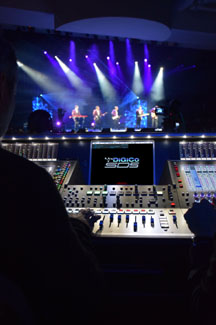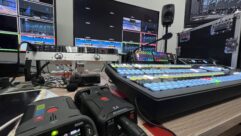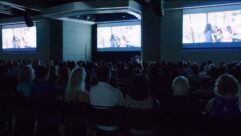
SVC Podcast – Show Notes – Show 145-2:
In this edition of the SVC Podcast, SVC Contributing Editor Bennett Liles continues his talk with Joey Engel, a front-of-house sound engineer for the Cornerstone Church in San Antonio, Texas. He gets into the nuts and bolts of the recent digital upgrade at the church with a description of what had to be done to get the old infrastructure out and the new in. Joey details the training and setup of the DiGiCo consoles and the use of Waves Tracks Live to get the mixing system ready for services and other events.
Links of interest:
- Waves Tracks Live, multitrack recording software designed to capture live performances
- Difference Media the recording label of Cornerstone Church
- DiGiGrid MGB, a coaxial MADI interface for the Waves SoundGrid networking and processing platform
Download Podcast Here:
https://s3.amazonaws.com/nb-svc/public/public/Cornerstone_Church_Joey_En…
From Sound & Video Contractor Magazine, this is the SVC Podcast with Joey Engel of the Cornerstone Church. Show notes for the podcast are available on the web site of Sound & Video Contractor Magazine at svconline.com.
Out with the old and in with the all-digital new. The fiber distribution and new DiGiCo sound mixing consoles have taken over at the Cornerstone Church in San Antonio and front-of-house sound engineer Joey Engel is back to wrap up his account of how it all got installed and set up. That’s coming up next on the SVC Podcast.
Joey, thanks for being back with us for Part 2 on the SVC Podcast from the Cornerstone Church in San Antonio. That’s a powerhouse of religious music and you had the big whole-house digital upgrade with DiGiCo mixers and fiber sound distribution. Did you do the piece-by-piece approach or, as I think was the case, just shut down the old system and replace it all at one time?
Well, it’s great to be back, Bennett. Thank you so much for having us. The planning for switching over our system was nothing less than God because we had just several days to get it done and be ready for a Sunday morning service. And so the guys from DiGiCo, Ryan Shelton, and one of the employees from DiGiCo, Taidus, was also very instrumental. [Timestamp: 1:41]
Okay, and I hope I’m pronouncing it right but I think that was Taidus Vallandi.
Yes. They came out and they helped us work on getting these mixers set up in a classroom setting. We actually set them up in our choir loft during the week, so Monday through Saturday we had the mixers out in the choir loft and we were running back a service that we had recorded off of multitrack. And so we were setting up the consoles and labeling, doing some really just preliminary gain stages and different things like that. And we did that for a total of three weeks and by the end of the second week we had actually had all the fiber pulled – not through conduit, but we had it pulled so that we could have an exact scenario of how this would work when we set it up. So before we ever disconnected the old system, we actually had the new system up and running and checked out with broadcast, checked out front-of-house, and checked out at monitor world. So it was really great. [Timestamp: 2:46]
So you didn’t have to go through and pull out all of the existing copper right away, but eventually you just got rid of all the copper infrastructure.
Correct. My backup plan was if we couldn’t pull that copper out in the couple of days that we needed to, we had a run of tactical fiber that went from our stage racks all the way to front-of-house. And Plan B was just to roll that out across the sanctuary floor, but we had already tried that with the same fiber we were going to install, so everything was the same. There was no question about whether or not this was going to work. The only question was whether or not we could get that copper out in time to install everything. But we had all the stage racks in place. When we actually did the install it was basically running the fiber and moving the consoles into their actual positions. [Timestamp: 3:36]
And we talked in Part 1 a little bit about it. There’s multi-track recording capability everywhere and when you were setting up the DiGiCo consoles and labeling everything you were using Waves Tracks Live in getting the system ready.
Correct, and that’s what we’re using to multitrack at front-of-house and at monitor world. It’s just a really good platform. It has tons of tracks – 118 or something like that – and that’s what we record our rehearsals on. And then we go back and we’re able to give the performers or the musicians or the music ministers anything that they want from the rehearsals so they can practice with it or critique them or pass them out to the orchestra or the band. [Timestamp: 4:18]
But one of the great things about it, and I’ve heard this from people before, is that DiGiCo sent people out there and worked with your crew in person to get all this set up and ready.
Yes. DiGiCo, they’re a key to the success of this; Ryan Shelton and Taidus coming out and training. They would come out and train us and then leave us alone for a few days, and then so when they came back we had the pointed questions that we needed to get answered specific to our services and to our needs. And so it was a good relationship. It was a good plan as far as they had. They were phenomenal. I can’t say enough about Ryan Shelton. He’s just available all the time and he knows those systems inside and out. [Timestamp; 4:59]
Those guys will come out and hold your hand if need be and get you whatever you need to get everything off on the right foot.
Super easy to work with, very accommodating, just willing to do whatever it took. And they had some really great ideas as far as making sure that the system was going to work, making sure that everything was in place before we disconnected the old system. Once you cut that copper you can’t go back. [Timestamp: 5:26]
Right. That’s jumping over the edge. Now you actually got two DiGiCo consoles, one for front-of-house and another one for stage monitoring.
Correct, yes. We have the SD5 at front-of-house and the SD 10 at monitor world.
Let’s see, the SD5 has got those LCD screens on it and that can be a little intimidating to first timers, I think.
Yes. And I am the chief of first timers because I mixed in that room for 20-plus years on an analog mixer. So the whole digital world is new to me, but again, Ryan and Taidus, the guys I work with, Danny and Franco, they’re all real experienced on digital stuff. They walked me through it and it’s really not that bad. It’s not as bad as I thought it was going to be. DiGiCo has a great layout and you can customize those mixers to basically whatever configuration you want. [Timestamp: 6:21]
A great thing about digital mixers for churches is that if you have any inexperienced operators or whatever, you can train them, turn them loose on it, let them experiment and then push one button and get it all back to where it was.
That’s exactly right. And having the Waves Tracks Live, what I would do is sit out there and run a service from the very beginning to the very end and just sit there and hit all the cues; do it until I could hit all the cues and know where everything was. Going from analog where everything is visible, you can touch all your EQ’s, your compressors, your gates, to having it hidden somewhere on your console was the biggest leap for me. But once you find out where it is, just the muscle memory, I guess, of doing it over and over with those tracks live and having the ability to play back a service was phenomenal. [Timestamp: 7:14]
And you had help not only from DiGiCo, but we talked a little in Part 1 about Kent Morris coming out there and working with you on the original design and setup of this whole system.
Correct. Kent was the consultant who actually turned us on to DiGiCo, and Kent is just an amazing resource of knowledge. At the very beginning of it he was just a really strong person as far as this is possible, you all can do this. I’m here to help you all. He was just a very calming and a very reassuring brother. [Timestamp: 7:50]
Right. Very knowledgeable and I know Kent and he’s very easy to work with. I was curious though about what happens each Sunday. Describe the steps you go through to get the whole operation ready for a Sunday service.
We have a system. Our crew in the sanctuary for the sound and the crew for broadcast, we get in between 4:30 and 5:00 in the morning and start turning everything on and checking all the inputs and everything. And then by 6:15-6:20, something like that, we do a total FAX check with the cameras, any roll-ins that we’re going to do, any curtain cues, any lighting cues, basically so that we have tested everything out that we’re going to use for the service before the orchestra comes out and starts rehearsing at 7:00. [Timestamp: 8:36]
Well, that’s one big freight train to get rolling in the right direction with all of the people and the equipment, but once you’ve done it a few times I guess everybody kind of settles into the routine? Maybe with a few little tweaks after the first few events, just honing it in.
Correct. Really there’s so much going on that we really learned that we can’t settle into a routine. We have to really stay sharp. We only get 52 shots at this a year and it’s the most important message out there. When we get to church on Sunday, you know it’s not really so much I’m just thrilled to be mixing for these people and getting to hear this dynamite orchestra and singers and everything, it’s who’s coming to church today? Who really needs to hear from God or they’re going to give it up or they’re going to make a bad decision, or they’re going to miss their opportunity to find out that God loves them? We’re just a tool in that, but we are thrilled to have the tools we have right now because there’s nothing really holding us back as far as sound goes now. I mean, there’s so many other things that they would love to be able to do in that building, but just the physical – without putting a second story on the building – that we’re going to have to figure out different things for projection. They’re training the little ones to go out there. They give the kids’ choirs, that these kids are three, four and five, six years old is the youngest choir, they give them time in the sanctuary to go out and perform and do songs and see what it feels like to minister to people. So they’re in it for the long haul and they’ve got 5-year, 10-year, 20-year, 30-year plans for raising people up to minister. So it’s exciting to be part of something that cares so much about the people that come here. [Timestamp: 10:26]
That’s got to be exciting for the kids to be able to go out and perform on the same stage as the performers. I’m sure it keeps them motivated. It’s been fun hearing about how all this came about, the whole fiber distribution system anchored by the DiGiCo consoles. Joey Engel front-of-house engineer for the Cornerstone Church in San Antonio, Texas. Big outfit, lots of music and I know you’re going to enjoy the new sound system.
Yes, we are enjoying the new sound system. Thank you so much, Bennett, and God bless you.
Thank you for being here with us for the SVC Podcast with Joey Engel of the Cornerstone Church in San Antonio, Texas. Show notes are available on the website of Sound & Video Contractor Magazine at svconline.com. Join us again next week for the next SVC Podcast.










